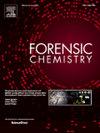Characterization and classification of organic gunshot residue from neat smokeless powder, cartridge cases, and the hands of known shooters
IF 2.2
3区 医学
Q2 CHEMISTRY, ANALYTICAL
引用次数: 0
Abstract
This study encompasses the detection, characterization, and classification of organic gunshot residue (OGSR) through the analysis of three forensically relevant sample types, including neat smokeless powders recovered from live ammunition, extracts from fired cartridge cases, and the hands of known shooters. Liquid chromatography-tandem mass spectrometry is used as an analytical tool for five manufacturer-grade ammunition brands. The relative detection and quantification of Akardite II, ethyl centralite, methyl centralite, diphenylamine, 2-nitrodiphenylamine, and 4-nitrodiphenylamine is used for chemical characterization and to reveal main chemical changes during deflagration. Classification via discriminant analysis methods is effective for neat smokeless powders and spent cartridge cases, reaching correct classification rates as high as 83.7 %. Alternative chemometric techniques, including k-nearest neighbors and support vector machine algorithms, are more appropriate for residues recovered from the shooter's hands that exhibit greater inter-sample variability. The more challenging traces of hand residues yield correct classification rates of up to 62.7 %, partly due to significant changes in the formation of nitro-diphenylamines and Akardite II in some organic gunshot residue. The findings presented in this study demonstrate that analyzing OGSR can offer valuable insights into the discrimination of manufacturer-spent cartridges and, to some extent, hand residues, assisting in forensic investigations and shooting reconstructions when limited evidence is available.

从干净的无烟火药、弹壳和已知射手的手中提取的有机射击残留物的特征和分类
本研究通过对三种法医相关样本类型的分析,包括从实弹中回收的纯无烟粉末、从发射的弹壳中提取的提取物和已知射手的手,包括有机射击残留物(OGSR)的检测、表征和分类。液相色谱-串联质谱法被用作五个制造级弹药品牌的分析工具。通过对赤铁矿、乙基中心石、甲基中心石、二苯胺、2-硝基二苯胺、4-硝基二苯胺的相对检测和定量,进行化学表征,揭示爆燃过程中的主要化学变化。判别分析方法对纯无烟火药和废药筒分类有效,分类正确率高达83.7%。替代化学计量学技术,包括k近邻和支持向量机算法,更适合从枪手的手上恢复残留物,表现出更大的样本间可变性。更具有挑战性的手残留物的正确分类率高达62.7%,部分原因是一些有机枪击残留物中硝基二苯胺和Akardite II的形成发生了重大变化。本研究的发现表明,分析OGSR可以为制造商使用的弹药的歧视提供有价值的见解,在某种程度上,手残留物,在证据有限的情况下,协助法医调查和射击重建。
本文章由计算机程序翻译,如有差异,请以英文原文为准。
求助全文
约1分钟内获得全文
求助全文
来源期刊

Forensic Chemistry
CHEMISTRY, ANALYTICAL-
CiteScore
5.70
自引率
14.80%
发文量
65
审稿时长
46 days
期刊介绍:
Forensic Chemistry publishes high quality manuscripts focusing on the theory, research and application of any chemical science to forensic analysis. The scope of the journal includes fundamental advancements that result in a better understanding of the evidentiary significance derived from the physical and chemical analysis of materials. The scope of Forensic Chemistry will also include the application and or development of any molecular and atomic spectrochemical technique, electrochemical techniques, sensors, surface characterization techniques, mass spectrometry, nuclear magnetic resonance, chemometrics and statistics, and separation sciences (e.g. chromatography) that provide insight into the forensic analysis of materials. Evidential topics of interest to the journal include, but are not limited to, fingerprint analysis, drug analysis, ignitable liquid residue analysis, explosives detection and analysis, the characterization and comparison of trace evidence (glass, fibers, paints and polymers, tapes, soils and other materials), ink and paper analysis, gunshot residue analysis, synthetic pathways for drugs, toxicology and the analysis and chemistry associated with the components of fingermarks. The journal is particularly interested in receiving manuscripts that report advances in the forensic interpretation of chemical evidence. Technology Readiness Level: When submitting an article to Forensic Chemistry, all authors will be asked to self-assign a Technology Readiness Level (TRL) to their article. The purpose of the TRL system is to help readers understand the level of maturity of an idea or method, to help track the evolution of readiness of a given technique or method, and to help filter published articles by the expected ease of implementation in an operation setting within a crime lab.
 求助内容:
求助内容: 应助结果提醒方式:
应助结果提醒方式:


